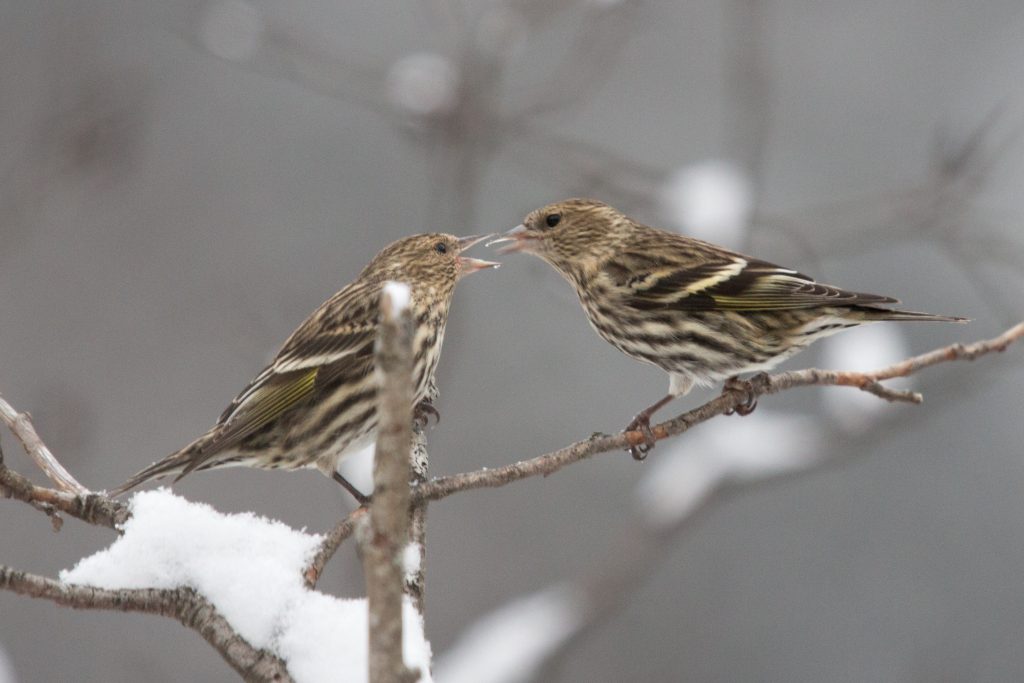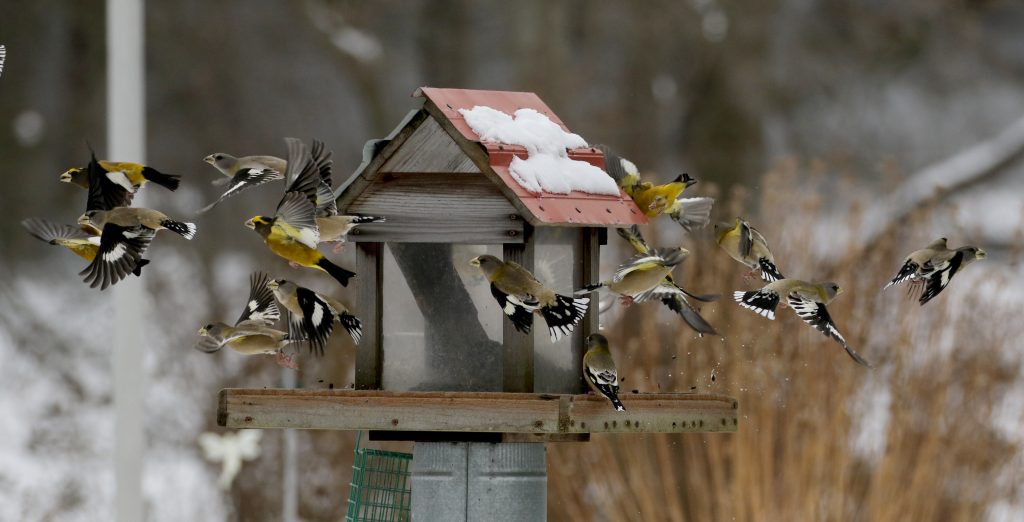Authors Tyler Hoar and Matthew A. Young:
With the warming days, the tree buds swell, and sparrows and other early migrating passerines start leaving the southern states. With them, the Budworm 3 will turn towards home. Birders in April, out chasing the first returning warblers, will enjoy the peak of the homeward bound budworm finches.
It is well known that Evening Grosbeaks and Purple Finches will change the majority of their diet to Spruce Budworms in areas of budworm outbreak. A third species, Pine Siskins, a versatile generalist feeding species, will also utilize budworm caterpillars and eat the budworm eggs later in the summer.
Currently, in Eastern Canada, there are four large Spruce Budworm outbreaks. The three largest outbreaks areas are in Quebec and a fourth large outbreak in Northeastern Ontario. In Northwestern Ontario, there is a large Jack Pine budworm outbreak as well.

Pine Siskin
Anyone who has watched feedercams on the web this winter will have noticed Pine Siskins flocks on these feeders from Arizona across the southern states to the Atlantic seaboard. Siskins even made it to Bermuda, the Everglades and northeastern Mexico this winter.
Siskins will start departing these southern areas in early March, with most departed by mid April. Pine Siskins have a protracted migration, so individuals and even small flocks can still be expected in these areas in early May. And, there’s almost always small numbers that breed along the high elevation spine of the southern Appalachians.
Peak migration will occur through the Lower Great Lakes and Pennsylvania eastward into New England from late April through the first half of May, with late birds still moving through at the end of the month. Although most siskins were in the southern parts of the States this winter, bird feeders that held siskins in the northern United States and southern Canada areas may not even notice the migration surge, as individuals that wintered at their feeders are replaced by migrants.
After irruption years, some individuals will remain in the summer south of the core breeding range. In suitable habitat in these areas, pairs may even breed, and some might even use feeders stations to augment the nesting event. Some Pine Siskins will already be breeding in areas of the northern United States as migrants are still moving through on their way towards Canada.

Purple Finch
This past fall, large numbers of “eastern” Purple Finches migrated southward to Florida and westward to Texas. A few “eastern” birds were even documented in Arizona. These southern wintering birds started departing these areas by early March, but a few late individuals should be expected to linger into early May from Arkansas eastward to North Carolina.
The main northward movement will occur in April with many still passing by into May. Peak migration occurs through the Lower Great Lakes, Pennsylvania and eastward to New England from late April to the first week of May, with late birds still moving through at the end of the month. Like Siskins, migrant Purple Finches will still be migrating through areas while the local pairs are already nesting.

Evening Grosbeak
After probably the fastest moving and possibly largest irruption in several decades, the Evening Grosbeaks will return home to eastern Canada and the ongoing Spruce Budworm outbreaks. Strong flights in the fall included day counts of 100s to 1300+ Evening Grosbeaks moving southwest along the Great Lakes shorelines in Ontario. How these and other Evening Grosbeaks return is the question.
A multi-year study on Evening Grosbeak wintering movements in western Pennsylvania using Motus tags by David Yeany at the Pennsylvania Natural Heritage Program has yielded some interesting early results. Individual birds returning to budworm outbreaks in the Saguenay area of Quebec have taken significantly different routes. One bird went east to Nova Scotia before turning back and heading northwest to Quebec. Another from western Pennsylvania went north into southern Ontario, and then took a right turn just north of Toronto and headed northeast towards its home in Quebec.
Will returning flocks travel northeastward along the south shores of the lower Great Lakes, through the Northeast aligned mountain ridges, or the Atlantic coastline?
Evening Grosbeaks in this irruption made it south into central Florida and southwest to Arkansas. Birds at these southern edges of the irruption should start to leave by early to mid March. Evening Grosbeaks’ main push should take place mid-April through mid-May, with some late migrants still passing through in early June. During the legendary irruptions in the 1970-80s, the Derby Hill Hawk Watch on Lake Ontario in New York had daily counts in the 100s during this main push period, including a count of 2980 on May 6, 1982!
For those watching feeders or enjoying newly arriving migrants at their favorite location, the budworm three are going to add color and charisma as they pass through northward on their journey home this spring.
Cover Photo Melissa Groo
FiRN is a nonprofit, and has been granted 501c3 status. FiRN is committed to researching and protecting these birds and other threatened finch species like the Evening Grosbeak and Rosy-finches, and if you have been enjoying all the blogs and identifying of Red Crossbill call types, redpoll subspecies and green morph Pine Siskins FiRN has helped with, please think about supporting our efforts and making a small donation at the donate link below. We plan to support student research projects and more.
Wildside Nature Tours and The Finchmasters – Finch Research Network (FiRN) are very excited to team up for our first partnership tour focusing on finch species of the Pacific Northwest! We’re really stoked about this. Its going to fun to be working with Alex Lamoreaux and Wildside Nature Tours. Let us know if you’re interested or have any questions. Read below for trip details.
For more on the return flight of finches, read here for more:

